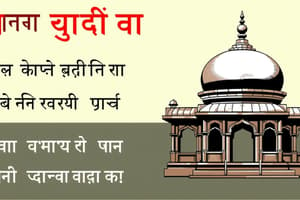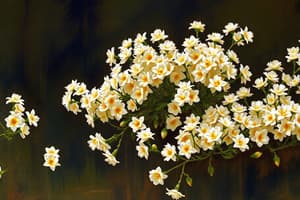Podcast
Questions and Answers
ગુજરાતી ભાષા ભારતમાં સૌથી જૂની ભાષાઓ માંથી એક છે.
ગુજરાતી ભાષા ભારતમાં સૌથી જૂની ભાષાઓ માંથી એક છે.
True (A)
ગુજરાતી ભાષા સેંસ્કૃત ભાષા પર આધાર રાખે છે.
ગુજરાતી ભાષા સેંસ્કૃત ભાષા પર આધાર રાખે છે.
True (A)
Gujarati ભाषानો શুரુ' થ' '0'0�-� '00 '0 ����0��� '0-' '0����' '0-' �0��0-���.
Gujarati ભाषानો શুரુ' થ' '0'0�-� '00 '0 ����0��� '0-' '0����' '0-' �0��0-���.
False (B)
Gujarati Language Devanagari script '49' letters including 29 consonants and 15 vowels use kare che.
Gujarati Language Devanagari script '49' letters including 29 consonants and 15 vowels use kare che.
Gujarati Language Rashtrakuta Empire Daur ma influence thai gayu hatu.
Gujarati Language Rashtrakuta Empire Daur ma influence thai gayu hatu.
Gujarati Language Persian, Arabic ane Portuguese foreign cultures thi influence thai gayu hatu.
Gujarati Language Persian, Arabic ane Portuguese foreign cultures thi influence thai gayu hatu.
ગુજરાતી ભાષામાં SOV શબ્દ ક્રમ હોય છે.
ગુજરાતી ભાષામાં SOV શબ્દ ક્રમ હોય છે.
ગુજરાતી ભાષા અને સંસ્કૃત ભાષા વચ્ચે સ્મૃત સં. આ. 400–1300, ફ. 500–1500, પ. 700–1700, અ. 950–1900
ગુજરાતી ભાષા અને સંસ્કૃત ભાષા વચ્ચે સ્મૃત સં. આ. 400–1300, ફ. 500–1500, પ. 700–1700, અ. 950–1900
Kutchhi dialect Gujarati ભાષા વിശേഷत: Pronunciation and vocabulary
Kutchhi dialect Gujarati ભાષા વിശേഷत: Pronunciation and vocabulary
Gujarati of Pakistan dialect Gujarati language influenced by Marathi language.
Gujarati of Pakistan dialect Gujarati language influenced by Marathi language.
Gujarati language uses prefixes and suffixes to modify verbs only.
Gujarati language uses prefixes and suffixes to modify verbs only.
Gujarati literature dates back to the 18th century CE.
Gujarati literature dates back to the 18th century CE.
Flashcards are hidden until you start studying
Study Notes
Introduction
The Gujarati language is one of the oldest languages in India and is classified within the Indo-Aryan family of languages. It originates from the state of Gujarat, which is located on the western coast of India. This region has been known for its trade since ancient times, making it likely that Gujarati was influenced by various foreign cultures such as Persian, Arabic, and Portuguese. Today, there are approximately 65 million speakers of the Gujarati language worldwide, with the majority residing in India and Pakistan. In this article, we will discuss the history, features, dialects, literature, and current status of the Gujarati language.
History and Origin
Gujarati has its roots in the ancient Sanskrit language. It is believed that the language developed from the Sanskrit dialect of Prakrit, which was used in the region during the 1st millennium BCE. The earliest traces of Gujarati are found in the inscriptions of the 10th century CE, during the Rashtrakuta Empire. The language was subsequently influenced by the Persian and Arabic languages due to the region's proximity to the Middle East. The Gujarati script was developed around the 14th century CE, and it has remained largely unchanged since then.
Features of Gujarati Language
The Gujarati language is written using the Devanagari script, which is also used for writing Hindi and Marathi. The script consists of 49 letters, including 34 consonants and 15 vowels. Gujarati uses a system of diacritic marks to indicate vowels and consonants.
Gujarati has a rich grammatical structure and follows a Subject-Object-Verb (SOV) word order. It has a large number of verbs, which can be used in various forms to express a wide range of meanings. The language is also known for its unique use of prefixes and suffixes to modify verbs, nouns, and adjectives.
Gujarati has a diverse vocabulary, with words borrowed from various sources such as Sanskrit, Persian, Arabic, and English. The language also has a rich tradition of folklore, which includes stories, songs, and proverbs.
Dialects of Gujarati Language
Gujarati has several dialects, with each region having its own unique features. Some of the notable dialects include:
-
Kathiawadi: Spoken in the Kathiawad region of Gujarat, this dialect is known for its unique pronunciation and vocabulary. It has been influenced by the Persian and Arabic languages due to the region's historical trade ties with the Middle East.
-
Saurashtra: Spoken in the Saurashtra region of Gujarat, this dialect is known for its unique accent and vocabulary. It has been influenced by the Jain religion, which is prevalent in the region.
-
Kutchhi: Spoken in the Kutch region of Gujarat, this dialect is known for its unique pronunciation and vocabulary. It has been influenced by the Persian language due to the region's proximity to Iran.
-
Gujarati of Pakistan: Spoken in Pakistan, this dialect has been influenced by Urdu and Punjabi languages. It has a different script known as the Shikasta script.
Literature and Culture
Gujarati literature has a rich history, with poems, stories, and plays dating back to the 15th century CE. Some of the notable Gujarati writers include:
-
Sudama Shah: A poet and philosopher who lived in the 15th century CE, Sudama Shah was one of the earliest Gujarati poets. His works include the famous poem "Suk Sagar".
-
Bhagwan Das: A poet and writer who lived in the 16th century CE, Bhagwan Das was known for his works on devotion and love. His most famous work is the poem "Premanand Vadhu".
-
Kumarpal Desai: A modern Gujarati writer, Kumarpal Desai is known for his works on social issues and human relationships. His most famous works include "Ramayan" and "Mahabharat".
Gujarati culture is known for its rich traditions in music, dance, and cuisine. Some of the popular Gujarati dishes include:
-
Dhokla: A steamed cake made from gram flour and semolina, often served with a tangy green chutney.
-
Khandvi: A thin, crispy snack made from gram flour and yogurt, often served with a spicy green chutney.
-
Thepla: A flatbread made from wheat flour and spices, often served with chutney or yogurt.
-
Ghana Nu Shak: A spicy lentil and vegetable curry, often served with rice or roti.
Current Status and Future of Gujarati Language
The Gujarati language is currently spoken by approximately 65 million people worldwide, with the majority residing in India and Pakistan. It is an official language in the state of Gujarat in India and is recognized as a minority language in Pakistan.
In recent years, there has been a renewed interest in promoting and preserving the Gujarati language. This is evident in the increasing number of Gujarati language schools and cultural centers around the world. There are also various initiatives to create digital resources for learning and preserving the language.
Despite these efforts, the Gujarati language faces several challenges, including the increasing influence of English and other regional languages. However, with continued support and efforts from the Gujarati community and the government, the Gujarati language is likely to continue thriving in the future.
Conclusion
The Gujarati language is a rich and vibrant language with a long history and diverse dialects. It has a unique grammatical structure and a rich vocabulary, with words borrowed from various sources. Despite the challenges it faces, the Gujarati language is likely to continue thriving in the future due to the efforts of the Gujarati community and the government. As a result, the Gujarati language will continue to play an important role in the cultural and linguistic diversity of the world.
Studying That Suits You
Use AI to generate personalized quizzes and flashcards to suit your learning preferences.




